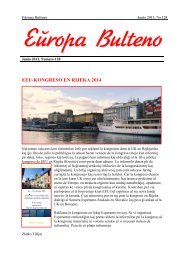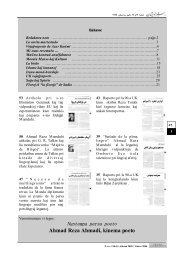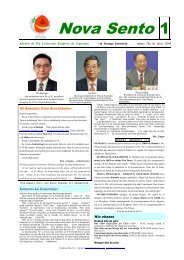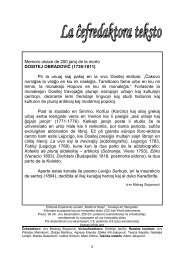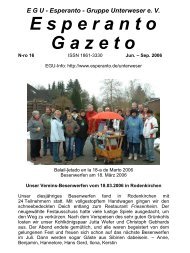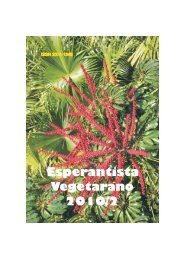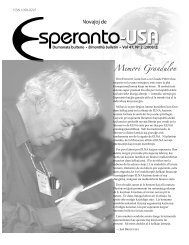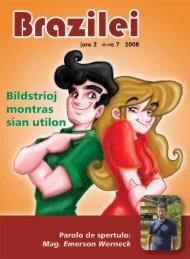ESPERANTOLOGIO ESPERANTO STUDIES - La Esperanta Gazetejo
ESPERANTOLOGIO ESPERANTO STUDIES - La Esperanta Gazetejo
ESPERANTOLOGIO ESPERANTO STUDIES - La Esperanta Gazetejo
Create successful ePaper yourself
Turn your PDF publications into a flip-book with our unique Google optimized e-Paper software.
Esperantologio / Esperanto Studies 1 (1999), 5–6<br />
Editorial Statement<br />
Christer Kiselman<br />
Dear reader:<br />
Welcome to the first issue of a new journal! It will publish works on all aspects of<br />
the linguistic, social, and psychological phenomenon Esperanto. Its name is bilingual,<br />
to indicate that it will contain articles in Esperanto as well as in other languages. It<br />
appears in a print version as well as in an electronic version. In this way I hope to<br />
achieve maximum availability.<br />
The journal is a kind of continuation: Between 1949 and 1961, Paul Neergaard<br />
published a journal with the name Esperantologio. A total of six issues were published.<br />
1 For a long time I was thinking about various ways to revive the journal. To<br />
guarantee high quality, I felt it would be essential to attract outstanding esperantologists<br />
and linguists to the idea. My proposal was welcomed by all the persons I<br />
contacted. They now form the Editorial Board, and I am most grateful to all of them<br />
for their support and for their efforts in the preparation of this first issue.<br />
On the term esperantologio<br />
The term esperantologio was introduced by Eugen Wüster in an article which appeared<br />
in 1921 in the journal Esperanto Triumfonta (later to be renamed Heroldo<br />
de Esperanto). In an article published in the journal Esperantologio he recounts the<br />
history of this term as well as that of interlingvistiko (Wüster 1955). For Wüster<br />
esperantologio denotes that branch of sinteza lingvistiko ‘synthetic linguistics’ which<br />
is applied to the already much used system of Esperanto. By sinteza lingvistiko he<br />
understands that relatively new branch of linguistics which not only observes but<br />
consciously influences (guides) the development of a language—nowadays we would<br />
say language planning. But he quotes other opinions as well, among them that of<br />
W. J. A. Manders, according to whom esperantologio is a science which observes and<br />
describes (Wüster 1955:211). The name of the present journal is to be understood<br />
in this sense.<br />
The article <strong>La</strong> Esperantologio kaj ties disciplinoj, which Neergaard published in<br />
1942, was important for early works on Esperanto. There he described in detail the<br />
various subbranches of Esperanto studies, and sketched the steps to be taken.<br />
The policy of this journal<br />
The phenomenon Esperanto is difficult to pinpoint. In my experience, it signifies<br />
very different things to different people. Many dreams are attached to it. The forces<br />
which inspire persons to learn and explore the language are of many kinds and hard<br />
to describe. Indeed it would be difficult to formulate a description of these forces<br />
1 The tables of contents of all issues is available on the web at the URL<br />
http://www.math.uu.se/esperanto



